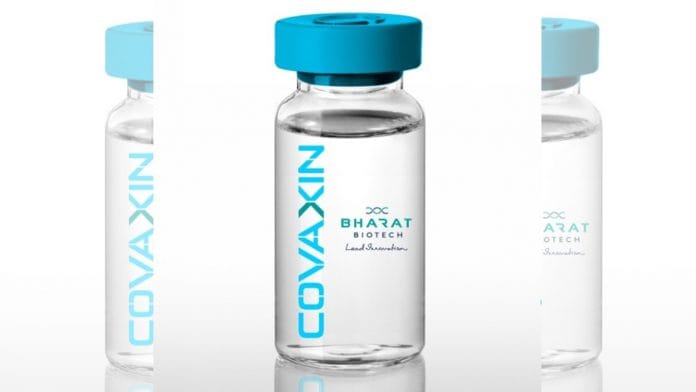New Delhi: India’s ‘first’ indigenous Covid-19 vaccine Covaxin, developed by Hyderabad-based vaccine manufacturer Bharat Biotech in collaboration with the Indian Council of Medical Research (ICMR), is all set to begin human clinical trials.
The Central Drugs Standard Control Organisation (CDSCO) had granted the company permission to initiate Phase I and II human clinical trials on 29 June, after it submitted results generated from pre-clinical studies, demonstrating the vaccine’s safety and immune response to the infection.
Recently, ICMR Director-General Dr Balram Bhargava also wrote to the principle investigators in the Covaxin trial asking for the vaccine to be launched by 15 August, triggering a massive controversy about how the timeline would be shrunk. Earlier, the company had submitted that the trials will be conducted over 15 months.
As Covaxin gears up for human trials, here are some details about the vaccine and how it works.
Also read: ICMR wants Covid vaccine by 15 August but documents show it’s a 15-month trial
An ‘inactivated’ vaccine
Vaccines can broadly be categorised into two types — inactivated and live vaccines.
Bharat Biotech’s Covaxin vaccine falls under the category of inactivated vaccines.
In such vaccines, the pathogen is ‘deactivated’ so that it can no longer cause infection. However, parts of the virus can still be identified by the body’s immune system and can trigger an immune reaction.
Hepatitis A, influenza, and polio vaccines used in India are some examples of inactivated vaccines.
Conversely, live attenuated vaccines carry a live but extremely weakened pathogen which cannot cause the disease, such as the measles or the Bacillus Calmette–Guérin vaccine, used primarily against tuberculosis.
Inactivated vaccines are not as powerful as live ones and typically require booster shots. However, the inactive pathogen cannot replicate in the vaccinated person, making it safer for people with an impaired immune system response.
Once the vaccine is administered, the body produces antibodies that can fight off the novel coronavirus infection.
Also read: ‘Meant to cut red-tape, not scientific rigour’ — ICMR defends bid to fast-track Covid vaccine
Influenza vaccine — first successful inactivated vaccine
The first inactivated vaccines were developed by Daniel Elmer Salmon and Theobald Smith in the US and the Pasteur Institute group in France. Inactivation was first applied to pathogens such as typhoid, plague, and cholera bacilli.
The first successful inactivated vaccine was developed for influenza in the 1930s.
An inactivated vaccine, also referred to as killed vaccines, can either carry the entire killed pathogen, such as the rabies or influenza vaccines, or be a subunit vaccine, which contains parts of a pathogen which successfully triggers immune reaction in the body.
Hepatitis B and Human papillomavirus (HPV) vaccines are subunit vaccines.
However, it is unclear which category the Covaxin vaccine falls under.
Furthermore, since most Covid vaccines under development use the spike protein of the virus to trigger the production of antibodies, Covaxin is also expected to do the same.
The spike protein of SARS-CoV-2 helps the virus latch onto and infect human cells.
To develop the vaccine, scientists at Bharat Biotech have used a SARS-CoV-2 strain that was isolated at the National Institute of Virology in Pune.
Also read: From Phase 0 to long-term study, a look at how long it actually takes to develop a vaccine







Can some one take two or more vaccines?
You don’t get affected if you take three or four does at a time but this do not means that it will work more if you take more.
We want regular does but in long interval for boosting your immunity because this vaccine is not so efficient as other vaccine in which we use living virus or bacteria. Hope this help you to understand